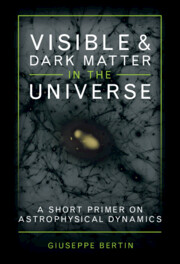Refine listing
Actions for selected content:
16950 results

Visible and Dark Matter in the Universe
- A Short Primer on Astrophysical Dynamics
-
- Published online:
- 08 December 2022
- Print publication:
- 22 December 2022
15 - Applications to Galaxies
- from Part III - Applications
-
- Book:
- Noether Symmetries in Theories of Gravity
- Published online:
- 10 November 2022
- Print publication:
- 24 November 2022, pp 294-309
-
- Chapter
- Export citation
4 - Development of Large-Volume Diamond Anvil Cell for Neutron Diffraction: The Neutron Diamond Anvil Cell Project at ORNL
-
-
- Book:
- Static and Dynamic High Pressure Mineral Physics
- Published online:
- 03 August 2023
- Print publication:
- 24 November 2022, pp 79-92
-
- Chapter
- Export citation
18 - Strings, Swampland, Renormalizability, and Viability
- from Part III - Applications
-
- Book:
- Noether Symmetries in Theories of Gravity
- Published online:
- 10 November 2022
- Print publication:
- 24 November 2022, pp 351-375
-
- Chapter
- Export citation
9 - Extensions with Higher Derivatives of R and T
- from Part II - The Noether Symmetry Approach
-
- Book:
- Noether Symmetries in Theories of Gravity
- Published online:
- 10 November 2022
- Print publication:
- 24 November 2022, pp 165-173
-
- Chapter
- Export citation
References
-
- Book:
- Noether Symmetries in Theories of Gravity
- Published online:
- 10 November 2022
- Print publication:
- 24 November 2022, pp 398-423
-
- Chapter
- Export citation
16 - Applications to Cosmology
- from Part III - Applications
-
- Book:
- Noether Symmetries in Theories of Gravity
- Published online:
- 10 November 2022
- Print publication:
- 24 November 2022, pp 310-333
-
- Chapter
- Export citation
Notation
-
- Book:
- Noether Symmetries in Theories of Gravity
- Published online:
- 10 November 2022
- Print publication:
- 24 November 2022, pp xxii-xxiii
-
- Chapter
- Export citation
2 - The Two Noether Theorems
- from Part I - Preliminaries
-
- Book:
- Noether Symmetries in Theories of Gravity
- Published online:
- 10 November 2022
- Print publication:
- 24 November 2022, pp 16-33
-
- Chapter
- Export citation
Part II - The Noether Symmetry Approach
-
- Book:
- Noether Symmetries in Theories of Gravity
- Published online:
- 10 November 2022
- Print publication:
- 24 November 2022, pp 105-106
-
- Chapter
- Export citation
Contributors
-
- Book:
- Static and Dynamic High Pressure Mineral Physics
- Published online:
- 03 August 2023
- Print publication:
- 24 November 2022, pp vii-ix
-
- Chapter
- Export citation
5 - Toward Quantum Gravity
- from Part I - Preliminaries
-
- Book:
- Noether Symmetries in Theories of Gravity
- Published online:
- 10 November 2022
- Print publication:
- 24 November 2022, pp 88-105
-
- Chapter
- Export citation
Part I - Preliminaries
-
- Book:
- Noether Symmetries in Theories of Gravity
- Published online:
- 10 November 2022
- Print publication:
- 24 November 2022, pp 1-2
-
- Chapter
- Export citation
6 - From the Noether Theorem to the Noether Symmetry Approach
- from Part II - The Noether Symmetry Approach
-
- Book:
- Noether Symmetries in Theories of Gravity
- Published online:
- 10 November 2022
- Print publication:
- 24 November 2022, pp 107-122
-
- Chapter
- Export citation
3 - Applications of Synchrotron and FEL X-Rays in High-Pressure Research
-
-
- Book:
- Static and Dynamic High Pressure Mineral Physics
- Published online:
- 03 August 2023
- Print publication:
- 24 November 2022, pp 42-78
-
- Chapter
- Export citation
Contents
-
- Book:
- Static and Dynamic High Pressure Mineral Physics
- Published online:
- 03 August 2023
- Print publication:
- 24 November 2022, pp v-vi
-
- Chapter
- Export citation
8 - Equations of State of Selected Solids for High-Pressure Research and Planetary Interior Density Models
-
-
- Book:
- Static and Dynamic High Pressure Mineral Physics
- Published online:
- 03 August 2023
- Print publication:
- 24 November 2022, pp 147-188
-
- Chapter
- Export citation
Copyright page
-
- Book:
- Static and Dynamic High Pressure Mineral Physics
- Published online:
- 03 August 2023
- Print publication:
- 24 November 2022, pp iv-iv
-
- Chapter
- Export citation
3 - Applications of Synchrotron and FEL X-Rays in High-Pressure Research
-
-
- Book:
- Static and Dynamic High Pressure Mineral Physics
- Published online:
- 03 August 2023
- Print publication:
- 24 November 2022, pp 42-78
-
- Chapter
- Export citation
Epilogue
-
- Book:
- Noether Symmetries in Theories of Gravity
- Published online:
- 10 November 2022
- Print publication:
- 24 November 2022, pp 376-377
-
- Chapter
- Export citation
